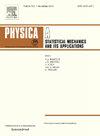Hypergraph Kolmogorov–Arnold Networks for station level meteorological forecasting
IF 2.8
3区 物理与天体物理
Q2 PHYSICS, MULTIDISCIPLINARY
Physica A: Statistical Mechanics and its Applications
Pub Date : 2025-06-09
DOI:10.1016/j.physa.2025.130725
引用次数: 0
Abstract
Weather forecasting plays a vital role in various domains, including disaster prevention, resource management, and energy optimization. Meteorological observation data are crucial for accurate weather forecasting, as they provide the spatial and temporal information needed to capture complex weather patterns. Graph Neural Networks (GNNs), due to their ability to handle non-Euclidean spatial relationships, can model the spatial dependencies among weather stations and have achieved good results in various weather prediction tasks. However, traditional graph neural networks, while effective at modeling spatial relationships between weather stations, often fall short in capturing the complex, multi-dimensional dependencies across different scales. This paper introduces a novel multi-information spatio-temporal hypergraph learning framework to overcome these limitations. By integrating neighborhood and semantic hypergraph convolutional networks, the framework effectively aggregates information from both spatially adjacent and semantically similar weather data, enabling it to capture intricate spatial and temporal features. Additionally, the Kolmogorov–Arnold Network (KAN) is introduced to enhance the model’s ability to learn dynamic, high-dimensional feature representations through the use of learnable univariate functions instead of fixed linear weights. Experiments on benchmark weather datasets show that the proposed method surpasses traditional spatio-temporal graph neural networks, providing higher accuracy and robustness in predicting complex meteorological phenomena.
台站级气象预报的超图Kolmogorov-Arnold网络
天气预报在灾害预防、资源管理、能源优化等领域发挥着重要作用。气象观测数据对于准确的天气预报至关重要,因为它们提供了捕捉复杂天气模式所需的空间和时间信息。图神经网络(Graph Neural Networks, gnn)由于具有处理非欧几里得空间关系的能力,可以对气象站之间的空间依赖关系进行建模,并在各种天气预报任务中取得了良好的效果。然而,传统的图形神经网络虽然能有效地模拟气象站之间的空间关系,但在捕捉不同尺度上复杂的多维依赖关系方面往往存在不足。本文提出了一种新的多信息时空超图学习框架来克服这些限制。通过整合邻域和语义超图卷积网络,该框架有效地从空间相邻和语义相似的天气数据中聚合信息,使其能够捕获复杂的时空特征。此外,还引入了Kolmogorov-Arnold网络(KAN),通过使用可学习的单变量函数而不是固定的线性权重来增强模型学习动态高维特征表示的能力。在基准气象数据集上的实验表明,该方法优于传统的时空图神经网络,对复杂气象现象的预测具有更高的精度和鲁棒性。
本文章由计算机程序翻译,如有差异,请以英文原文为准。
求助全文
约1分钟内获得全文
求助全文
来源期刊
CiteScore
7.20
自引率
9.10%
发文量
852
审稿时长
6.6 months
期刊介绍:
Physica A: Statistical Mechanics and its Applications
Recognized by the European Physical Society
Physica A publishes research in the field of statistical mechanics and its applications.
Statistical mechanics sets out to explain the behaviour of macroscopic systems by studying the statistical properties of their microscopic constituents.
Applications of the techniques of statistical mechanics are widespread, and include: applications to physical systems such as solids, liquids and gases; applications to chemical and biological systems (colloids, interfaces, complex fluids, polymers and biopolymers, cell physics); and other interdisciplinary applications to for instance biological, economical and sociological systems.

 求助内容:
求助内容: 应助结果提醒方式:
应助结果提醒方式:


